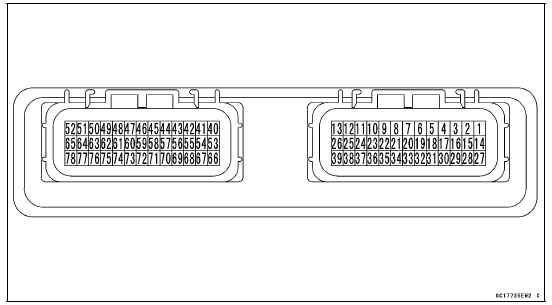


1. Subthrottle Valve Actuator: Y/BK
2. Subthrottle Valve Actuator: BK/O
3. Unused
4. Front Wheel Rotation Sensor Signal: G/Y
5. Unused
6. Starter Lockout Switch: R/G
7. Gear Position Switch: G/R
8. Crankshaft Sensor (–): BK
9. Power Supply to Sensors: BL
10. Unused
11. Intake Air Pressure Sensor #2: G/W
12. Subthrottle Sensor: BL/W
13. Ground for Sensors: BR/BK
14. Subthrottle Valve Actuator: P/BL
15. Subthrottle Valve Actuator: G
16. Unused
17. Starter Button: BK/R
18. Unused
19. Sidestand Switch: G/BK
20. Unused
21. Crankshaft Sensor (+): Y
22. Intake Air Pressure Sensor #1: Y/BL
23. Water Temperature Sensor: O
24. Exhaust Butterfly Valve Actuator Sensor: GY
25. Main Throttle Sensor: V/W
26. Immobilizer Amplifier (Equipped Models): P/BK
27. CAN Communication Line (High): GY/BL
28. CAN Communication Line (Low): LB
29. Unused
30. Unused
31. Unused
32. Unused
33. Unused
34. Rear Wheel Rotation Sensor Signal: R/Y
35. Oxygen Sensor (Equipped Models): W/BL
36. Unused
37. Intake Air Temperature Sensor: R/BK
38. Vehicle-down Sensor: Y/G
39. Immobilizer Amplifier (Equipped Models): V
40. Ground for Control System: BK/Y
41. Power Supply to ECU (from Battery): W/BK
42. Idle Speed Control Valve Actuator: G/BK
43. Idle Speed Control Valve Actuator: G/Y
44. Idle Speed Control Valve Actuator: G/O
45. Exhaust Butterfly Valve Actuator (–): W/R
46. Exhaust Butterfly Valve Actuator (+): W/BL
47. Primary Fuel Injector #1: BL/R
48. Primary Fuel Injector #2: BL/O
49. Primary Fuel Injector #3: BL/BK
50. Primary Fuel Injector #4: BL/Y
51. Stick Coil #4: BK/O
52. Stick Coil #2: BK/R
53. Power Supply to ECU (from Ignition Switch): BR/W
54. Power Supply to ECU (from Battery): W/BK
55. External Communication Line (Immobilizer System (Equipped Models)/*KDS): LG/BK
56. Idle Speed Control Valve Actuator: G/R
57. Secondary Fuel Injector #1: O/R
58. Power Supply to Wheel Rotation Sensors (ZX1000J Model): R Unused (ZX1000K Model)
59. Air Intake Solenoid Valve (Other than US, CA and CAL Models): R/W
60. Air Switching Valve: R/BL
61. Secondary Fuel Injector #3: O/BK
62. Secondary Fuel Injector #4: O/Y
63. Unused
64. Unused
65. Stick Coil #1: BK
66. Unused
67. Unused
68. Unused
69. Battery Monitor Voltage Line: W/R
70. Radiator Fan Relay: P/BL
71. Fuel Pump Relay: BR/Y
72. Secondary Fuel Injector #2: O/G
73. Engine Ground: BK/Y
74. Engine Ground: BK/Y
75. Unused
76. Oxygen Sensor Heater (Equipped Models): R
77. Unused
78. Stick Coil #3: BK/W
*: KDS (Kawasaki Diagnostic System)
 DFI System Wiring Diagram (KIBS Equipped Models)
DFI System Wiring Diagram (KIBS Equipped Models) DFI Parts Location
DFI Parts LocationAir Suction Valve Inspection
Remove the air suction valve (see Air Suction Valve Removal).
Visually inspect the reeds [A] for cracks, folds, warps,
heat damage or other damage.
If there is any doubt as to the condition of the reeds, replace
the air suction valve as an assembly.
Check the reed contact areas [B] of ...
Armature Inspection
Using the × 1 Ω hand tester range, measure the resistance
between any two commutator segments [A].
Special Tool - Hand Tester: 57001-1394
If there is a high resistance or no reading (∞) between any
two segments, a winding is open and the starter motor
must be replaced.
...
Exploded View
13. Front Wheel Rotation Sensor
B: Apply brake fluid.
L: Apply a non-permanent locking agent.
R: Replacement Parts
S: Follow the specified tightening sequence.
Si: Apply silicone grease (ex. PBC grease).
10. Rear Wheel Rotation Sensor
B: Apply brake fluid.
G: Apply gr ...